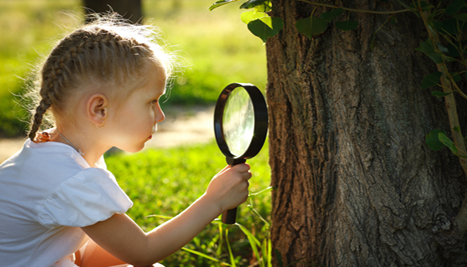Summer has just arrived, and like you, we’ve been looking for new ways to get outside and do some great science. With both an eight-and-a-half-year-old and a five-year-old in the house, the question this summer is, how can we (and you) get your youngest children thinking like a scientist and engage different age levels at the same time? We turn to an old classic game and add a few twists: “I Spy.”
Observation is the very heart of science. The “Oxford English Dictionary” defines the scientific method as: “a method or procedure that has characterized natural science since the 17th century, consisting in systematic observation, measurement, and experiment, and the formulation, testing, and modification of hypotheses.”
Observation and measurement can be utilized in many ways and can easily be adapted to many age ranges. When you play “I Spy,” you can vary the object in different ways—you can spy a color or a size (bring a tape measure and spy something one foot long, for example). You can also spy something distant like the sun or moon. We also play “I Hear with My Little Ear”—ask your children to sit or stand still and see what different things you can pick out of the background noise. You can easily vary what you are listening for to suit your location or needs. You can find a quiet spot to listen to birds and compare the pleasant songs of a cardinal to the not so nice sound of crows or catbirds. When animals call, what are they saying to each other? Or listen for patterns—a rhythmic drip from a gutter after a rain or the sound of a passing car or bike. Be as specific as your ages will allow, and again, ask for something unexpected. Ask for a soft sound or a grating sound—maybe the sound of a rake reaching concrete. What are all the ways that you can categorize sounds?
Take a brown paper bag outside and play “I Feel”—same rules, only no peeking! Pick three or four different leaves off of nearby trees and see if you can identify them just by feeling them. There should be clear rules about what goes in the bag: nothing sharp or dangerous, no bugs or animals. But there is really no limit to what can go inside—a cotton ball, an acorn, a flower petal. Ask them to describe the difference between a flower petal and a leaf. Why are flowers smoother and softer than leaves? Or why are sedimentary rocks smoother than other rocks?
Finally, the truly adventurous can play “I Smell” or even “I Taste.” “I Smell” can be both good and bad—be prepared for some potty talk and to have your breath or hair analyzed. If you choose to play “I Taste,” make sure the rules are firmly established and think about fun. I remember playing this game when I was a kid and being given juice from a pickle jar to taste, which was not fun! But if you prepare three or four things and explain the range (one sweet, one salty, one sour, etc.), you can have a lot of fun without negative surprises.
A great way to tie them all together is to come up with a theme. Choose a basic and open theme, like the weather: what can you spy that says summer, but definitely does not say spring, fall or winter? Popsicles, lawn sprinklers, dogs with their tongues hanging out. … Similarly, there are sounds and smells and things to touch that only happen in summer weather. Does heat have a smell? Things get hot in the summer, but how does a cool breeze feel?
Remember to keep it fun, but focus on seeing (and hearing and smelling) things in new ways, and especially think of ways to observe like a scientist. Pick things that show the difference between the qualitative and quantitative, like an unusual flower, not in how it looks but in how many there are on a plant or stem. Slow down, look around, start observing like a scientist, and always follow up with questions that lead to more questions. You don’t have to answer all the questions—just help the kids form a good way to ask them. I spy with my little eye…little scientists having fun! And I hear with my little ear…the sound of little scientists laughing and having fun!
Vince Harriman is a contributor to cwist.com—kids’ challenges with a twist—where he writes science activities for kids and is the author of the widely followed blog Kids Need Science. He is also known as Science Dad on NPR’s Science Friday blog. He lives in Annapolis, Maryland, with his two sons, who ask him “why” approximately 6,542 times a day.
